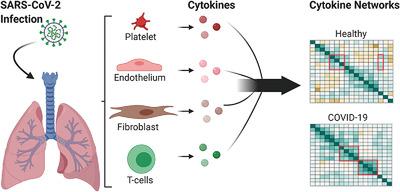当前位置:
X-MOL 学术
›
J. Leukoc. Biol.
›
论文详情
Our official English website, www.x-mol.net, welcomes your
feedback! (Note: you will need to create a separate account there.)
Cytokine release syndrome in COVID-19: Innate immune, vascular, and platelet pathogenic factors differ in severity of disease and sex.
Journal of Leukocyte Biology ( IF 3.6 ) Pub Date : 2020-09-15 , DOI: 10.1002/jlb.3cova0820-410rrr Aaron C Petrey 1, 2 , Fares Qeadan 3 , Elizabeth A Middleton 1, 4 , Irina V Pinchuk 5 , Robert A Campbell 1, 4 , Ellen J Beswick 2, 4
Journal of Leukocyte Biology ( IF 3.6 ) Pub Date : 2020-09-15 , DOI: 10.1002/jlb.3cova0820-410rrr Aaron C Petrey 1, 2 , Fares Qeadan 3 , Elizabeth A Middleton 1, 4 , Irina V Pinchuk 5 , Robert A Campbell 1, 4 , Ellen J Beswick 2, 4
Affiliation

|
COVID‐19 rapidly emerged as a crippling public health crisis in the last few months, which has presented a series health risk. Understanding of the immune response and biomarker analysis is needed to progress toward understanding disease pathology and developing improved treatment options. The goal of this study is to identify pathogenic factors that are linked to disease severity and patient characteristics. Patients with COVID‐19 who were hospitalized from March 17 to June 5, 2020 were analyzed for clinical features of disease and soluble plasma cytokines in association with disease severity and sex. Data from COVID‐19 patients with acute illness were examined along with an age‐ and gender‐matched control cohort. We identified a group of 16 soluble factors that were found to be increased in COVID‐19 patients compared to controls, whereas 2 factors were decreased. In addition to inflammatory cytokines, we found significant increases in factors known to mediate vasculitis and vascular remodeling (PDGF‐AA, PDGF‐AB‐BB, soluble CD40L (sCD40L), FGF, and IP10). Four factors such as platelet‐derived growth factors, fibroblast growth factor‐2, and IFN‐γ‐inducible protein 10 were strongly associated with severe disease and ICU admission. Th2‐related factors (IL‐4 and IL‐13) were increased with IL‐4 and sCD40L present at increased levels in males compared with females. Our analysis revealed networking clusters of cytokines and growth factors, including previously unknown roles of vascular and stromal remodeling, activation of the innate immunity, as well activation of type 2 immune responses in the immunopathogenesis of COVID‐19. These data highlight biomarker associations with disease severity and sex in COVID‐19 patients.
中文翻译:

COVID-19 中的细胞因子释放综合征:先天免疫、血管和血小板致病因素因疾病的严重程度和性别而异。
在过去几个月中,COVID-19 迅速成为严重的公共卫生危机,带来了一系列健康风险。需要了解免疫反应和生物标志物分析,以了解疾病病理学和开发改进的治疗方案。本研究的目的是确定与疾病严重程度和患者特征相关的致病因素。分析了 2020 年 3 月 17 日至 6 月 5 日住院的 COVID-19 患者的疾病临床特征和与疾病严重程度和性别相关的可溶性血浆细胞因子。来自 COVID-19 急性疾病患者的数据与年龄和性别匹配的对照队列一起进行了检查。我们确定了一组 16 种可溶性因子,与对照组相比,这些因子在 COVID-19 患者中有所增加,而减少了2个因素。除了炎性细胞因子外,我们发现已知介导血管炎和血管重塑的因素(PDGF-AA、PDGF-AB-BB、可溶性 CD40L (sCD40L)、FGF 和 IP10)显着增加。血小板衍生生长因子、成纤维细胞生长因子 2 和 IFN-γ 诱导蛋白 10 等四种因素与重症和入住 ICU 密切相关。与女性相比,男性的 IL-4 和 sCD40L 水平升高,Th2 相关因子(IL-4 和 IL-13)增加。我们的分析揭示了细胞因子和生长因子的网络集群,包括以前未知的血管和基质重塑作用、先天免疫的激活以及 COVID-19 免疫发病机制中 2 型免疫反应的激活。
更新日期:2020-09-15
中文翻译:

COVID-19 中的细胞因子释放综合征:先天免疫、血管和血小板致病因素因疾病的严重程度和性别而异。
在过去几个月中,COVID-19 迅速成为严重的公共卫生危机,带来了一系列健康风险。需要了解免疫反应和生物标志物分析,以了解疾病病理学和开发改进的治疗方案。本研究的目的是确定与疾病严重程度和患者特征相关的致病因素。分析了 2020 年 3 月 17 日至 6 月 5 日住院的 COVID-19 患者的疾病临床特征和与疾病严重程度和性别相关的可溶性血浆细胞因子。来自 COVID-19 急性疾病患者的数据与年龄和性别匹配的对照队列一起进行了检查。我们确定了一组 16 种可溶性因子,与对照组相比,这些因子在 COVID-19 患者中有所增加,而减少了2个因素。除了炎性细胞因子外,我们发现已知介导血管炎和血管重塑的因素(PDGF-AA、PDGF-AB-BB、可溶性 CD40L (sCD40L)、FGF 和 IP10)显着增加。血小板衍生生长因子、成纤维细胞生长因子 2 和 IFN-γ 诱导蛋白 10 等四种因素与重症和入住 ICU 密切相关。与女性相比,男性的 IL-4 和 sCD40L 水平升高,Th2 相关因子(IL-4 和 IL-13)增加。我们的分析揭示了细胞因子和生长因子的网络集群,包括以前未知的血管和基质重塑作用、先天免疫的激活以及 COVID-19 免疫发病机制中 2 型免疫反应的激活。











































 京公网安备 11010802027423号
京公网安备 11010802027423号